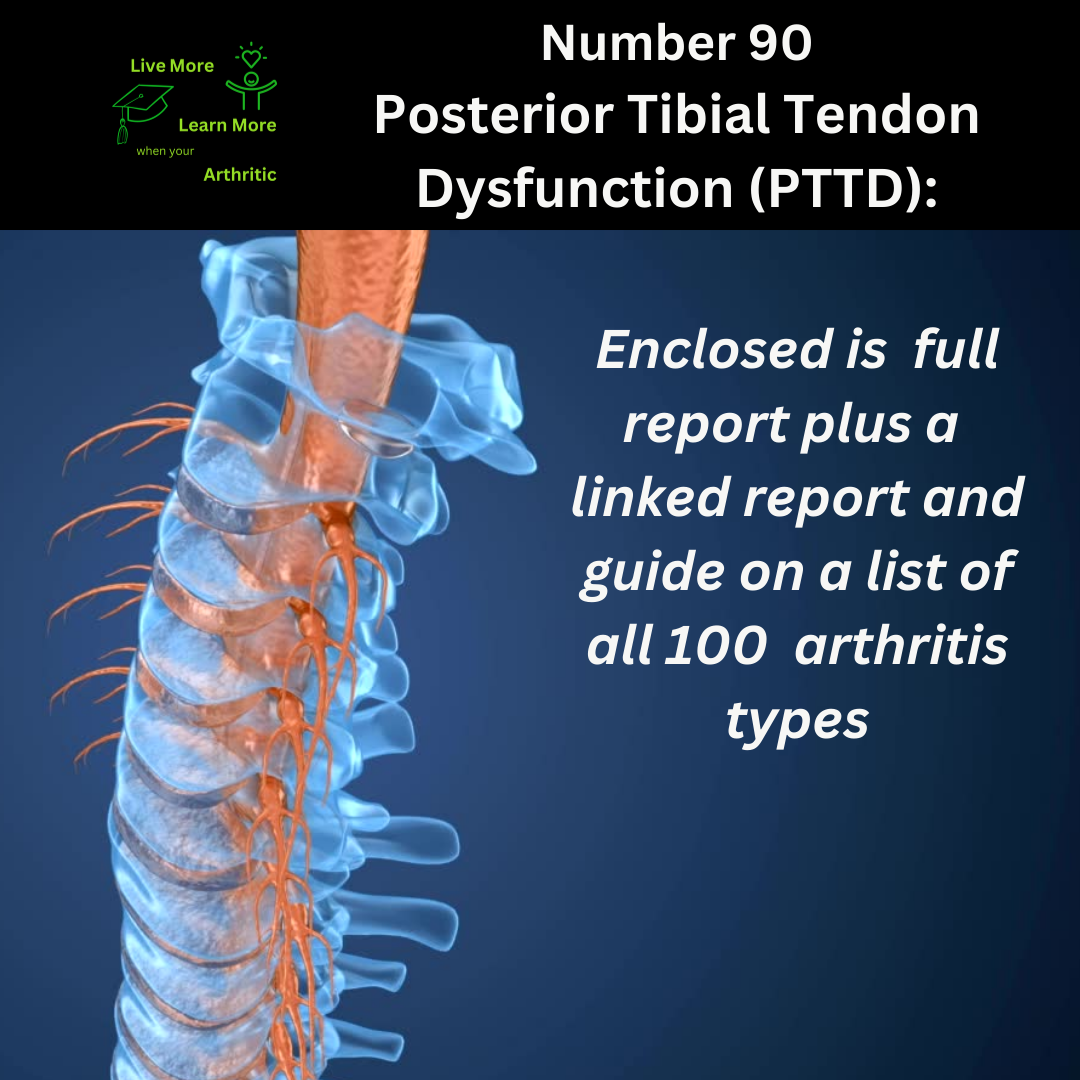
Posterior Tibial Tendon Dysfunction (PTTD): Number 90 on the list of 100 types of Arthritis
Exploring Posterior Tibial Tendon Dysfunction (PTTD)
Affected Body Parts and Joints
Posterior Tibial Tendon Dysfunction (PTTD) primarily affects the posterior tibial tendon, which runs along the inside of the ankle and foot. This tendon plays a crucial role in supporting the arch of the foot and stabilizing the ankle during walking and other weight-bearing activities.
PTTD, also known as adult acquired flatfoot deformity, is characterized by degeneration or inflammation of the posterior tibial tendon. This can lead to progressive weakening and dysfunction of the tendon, resulting in a collapsed arch and altered foot alignment. Over time, PTTD can cause significant foot and ankle pain, instability, and difficulty with walking.
Causes and Triggers
The exact cause of PTTD is not fully understood, but several factors may contribute to its development. These include repetitive stress or overuse of the posterior tibial tendon, trauma or injury to the tendon, obesity, and certain underlying medical conditions such as diabetes or rheumatoid arthritis. Aging and wear-and-tear on the tendon over time are also significant contributors.
Symptoms and Limited Range of Motion
Common symptoms of PTTD include pain and swelling along the inside of the ankle, especially with activity or prolonged standing. As the condition progresses, individuals may notice a flattening of the arch of the foot, leading to difficulty with walking on uneven surfaces and decreased range of motion in the affected ankle joint.
Age of Onset and Demographics
PTTD typically affects adults over the age of 50, although it can occur in younger individuals, especially those with predisposing factors such as obesity or foot abnormalities. Women are more commonly affected than men, possibly due to hormonal factors and differences in foot structure.
Complications and Impact on Quality of Life
Untreated PTTD can result in progressive deformity of the foot, chronic pain, and functional limitations. Complications may include arthritis of the foot and ankle joints, difficulty with balance and mobility, and an increased risk of falls. These factors can significantly impact daily activities and quality of life.
Is it Autoimmune?
PTTD is not considered an autoimmune disorder. Instead, it is primarily a degenerative condition resulting from mechanical stress and age-related changes in the posterior tibial tendon.
Risk Factors
Risk factors for developing PTTD include obesity, diabetes, hypertension, and activities that place repetitive stress on the feet and ankles (such as running or standing for long periods). Structural abnormalities of the foot, such as a high arch or flat feet, may also predispose individuals to PTTD.
Achieving a Higher Quality of Life
A proactive approach to managing PTTD can help improve symptoms and quality of life. Strategies may include:
- Physical therapy to strengthen supportive muscles and improve foot biomechanics
- Custom orthotic devices to support the arch and reduce stress on the posterior tibial tendon
- Footwear modifications to provide adequate support and cushioning
- Weight management to reduce strain on the feet and ankles
Complications of PTTD may include chronic pain, progressive deformity of the foot, joint arthritis, and functional limitations that affect mobility and independence. In severe cases, surgical intervention may be necessary to restore foot alignment and function.
Interconnected Diseases or Conditions
Individuals with PTTD may be at increased risk for developing secondary osteoarthritis of the foot and ankle joints due to altered biomechanics and chronic inflammation. Close monitoring and comprehensive care by orthopedic specialists are essential to minimize complications and optimize outcomes.
In summary, Posterior Tibial Tendon Dysfunction (PTTD) is a degenerative condition that affects the posterior tibial tendon, leading to foot and ankle pain, instability, and progressive deformity. Understanding the disease process, risk factors, and management strategies is essential for preserving foot function and improving overall quality of life for individuals affected by PTTD.


